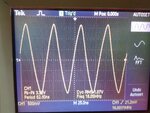shubh1994
Member level 1
I have 24 MHz sine wave and i want to convert it in 24MHz square wave , i have tried NAND gate(74lvc10) high speed but it giving same output as input,
i tried schmitt trigger(74lvc14A) even but not able to find the solution Now i am in big trouble,not getting any other way
So,please please help me out!!!!!!!!
i tried schmitt trigger(74lvc14A) even but not able to find the solution Now i am in big trouble,not getting any other way
So,please please help me out!!!!!!!!
